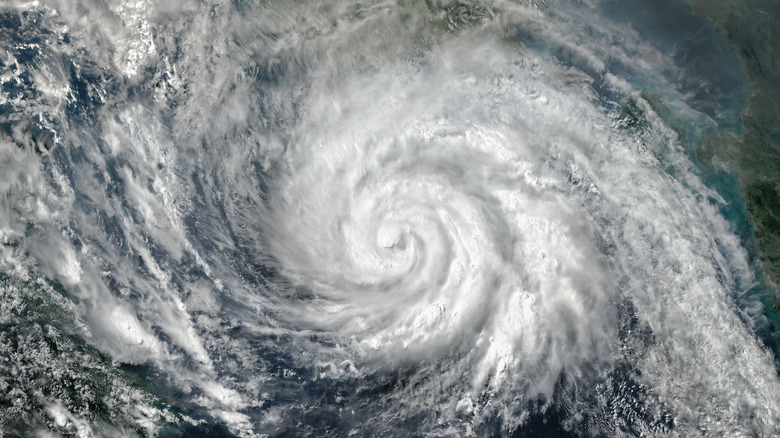What Is A Gigantic Jet Lightning Burst?
According to Yahoo News, scientists believe that 50,000 gigantic jets occur yearly. This phenomenon, as Phys.org writes, can be likened to a lightning bolt on steroids. The biggest difference, however, is that gigantic jets carry far more electrical charge compared to a regular lightning bolt. That being said, a 2022 study published in the Journal of Science Advances revealed that a gigantic jet that appeared over an Oklahoma thunderstorm carried 100 times more electrical charge than an average thunderstorm lightning bolt. This particular gigantic jet moved an estimated 300 coulombs of electrical charge into the ionosphere. In comparison, a typical lightning bolt carries less than 5 coulombs.
The Washington Post notes that this is the most powerful gigantic jet that has been studied so far. Moreover, gigantic jets are incredibly elusive — only five are captured each year, mostly by accident, either by photographers or satellites. IFLScience explains that while a lightning bolt strikes the ground, a gigantic jet travels up above the clouds and into the lower edge of space. In regards to the Oklahoma gigantic jet, scientists were able to study it using satellite data, radio waves, and radar. However, this would not be possible without a photo taken in Texas by a citizen scientist in 2018.
The gigantic jet in Oklahoma provided researchers with new insight
After viewing the photo, The Washington Post writes that Levi Boggs from the Georgia Tech Research Institute and his team got to work recreating how the gigantic jet occurred. Ultimately, they formed a 3D model of the jet using an instrument called a lightning mapper.
Steve Cummer, a professor of electrical and computer engineering at Duke and gigantic jet researcher, explained what they learned in their research. He stated (via (via Georgia Tech Research Institute), "The VHF [very high frequency] and optical signals definitively confirmed what researchers had suspected but not yet proven: that the VHF radio from lightning is emitted by small structures called streamers that are at the very tip of the developing lightning, while the strongest electric current flows significantly behind this tip in an electrically conducting channel called a leader."
Per IFLScience, the jet started from an area within a cloud that measured around 50 by 50 kilometers (31 by 31 miles). The charge sparked upwards until it reached the ionosphere. Boggs added (per Yahoo News!), "They [the streamers] propagate all the way to the lower ionosphere to an altitude of 50–60 miles, making a direct electrical connection between the cloud top and the lower ionosphere, which is the lower edge of space." This upward discharge also transfers negative charges from the cloud to the ionosphere (via Georgia Tech Research Institute). The study notes that this was the first time a gigantic jet had been three-dimensionally captured with a lightning mapper.
Questions remain about gigantic jets
Despite this, Phys.org reports that it is still unknown why gigantic jets shoot into space instead of the ground. Per the Georgia Tech Research Institute, researchers believe that something is blocking the flow of charge downward. Interestingly, The Washington Post notes that there were not any average lightning strikes prior to the formation of the gigantic jet. IFLScience adds that the Oklahoma gigantic jet is notable due to its conditions — it occurred over land rather than the ocean. Per The Washington Post, gigantic jets form over tropical storms and hurricanes. The publication cites gigantic jets that occurred during Hurricane Hilda in 2015 as an example.
However, Bogg explained why the gigantic jet in Oklahoma may have occurred without the presence of lightning. He stated (via the Georgia Tech Research Institute), "There is a buildup of negative charge, and then we think that the conditions in the storm top weaken the uppermost charge layer, which is usually positive. In the absence of the lightning discharges we normally see, the gigantic jet may relieve the buildup of excess negative charge in the cloud." Phys.org reports that gigantic jets may have some implications for technology in the future, including interfering with satellites and radars. Ultimately, they could cause signal and performance issues.


